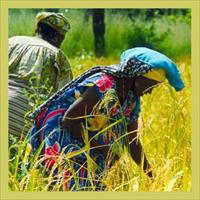SENEGAL: Squeezing more out of sesame

The Senegalese government has invested millions of dollars in the past decade to revive sesame production, but the sector has been slow to develop. Yet as profits decline for the country’s main cash crops - peanuts and cotton - and Asia’s demand for sesame grows, some producers are reconsidering the abandoned crop.
Government agricultural advisor Khardy Ndiaye told IRIN farmers have been reluctant to cultivate sesame, but face more pressure to find a viable cash crop with higher food prices and lower profits. “We have to adapt. Tastes change. Prices change. So we, too, need to change,” she said.
In recent years, international prices for cotton and national subsidies for peanuts have decreased; fuel price increases have further eroded farmers’ profits.
Demand
But despite increased worldwide demand and potential profits for sesame, some farmers in Ziguinchor – capital of the southern Casamance region – have yet to take to sesame. “It is still considered only as a back-up crop here,” said Sihounké Diatta of the government’s local agricultural agency. “There is traditionalism [preference for other cash crops] and the price is not that good.”
He said farmers earn on average 20 US cents more per kilogramme for sesame in neighbouring Gambia. The coordinator for the Agriculture Ministry’s sesame sector, Maguèye Thioune, told IRIN that Gambia’s port, which is larger than Senegal’s, attracts more exporters willing to pay competitive prices.
Almost half of the world’s sesame comes from Africa, mostly east Africa, according to the UN Food and Agriculture Organization. Senegal generally contributes less than 0.1 percent to total exports.
Supply
In 2003 the Senegalese government invested US$3 million in sesame production to “improve food security and reduce rural poverty”, according to a government report. Government sector coordinator Thioune said since then, production has increased from 2,500 metric tons to an expected 38,000 mt in 2009.
But the actual yield for 2009 is much smaller, said Dakar-based analyst Sidy Niang. “I have visited all the production zones [in February 2009] and met with the farmers. The yield will not even reach one-tenth of this estimate.” He said the government’s estimate is based on the number of seeds it distributes, but up to 70 percent of the crop is lost before harvest time, mostly due to planting inappropriate seed varieties and insufficient seed drying at harvest.
Government rural advisor Ndiaye told IRIN one reason so much of the crop is lost is that farmers use outdated methods. “The farmers think they know sesame planting, but they are using outdated, manual, time-consuming and labour-intensive practices.”
In 2008 the US Agency for International Development distributed 750 guides on sesame cultivation in French and in the country’s main local languages.
Pricing
Saoudatou Sonko, a sesame grower in the south of Senegal, told IRIN prices are too low. “We work for nothing growing sesame. If Senegal wants us to really grow sesame, it needs to work with the Chinese [export company] so they bring up their prices because otherwise, people will give up. Why should we work just to make someone else rich?”
China’s Datong Enterprise (DTE) is the largest purchaser of Senegal’s sesame, and pays on average 50 cents per kilo and provides farmers with seeds on credit.
Both the government’s Thioune and analyst Niang said in order for farmers to get higher prices, they need to form farmer associations and demand better seeds from DTE.
“Sesame grows in most climate conditions, does not require much water, has an international market and can boost rural economies that have been battered by high food prices,” said Thioune. “It is a small grain. But it holds a lot of potential.”
But that potential is not tapped, said analyst Niang. “The country has factories that can process more than 4,000 mt of sesame into oil and other valuable products.” But Senegal currently processes only one percent of this amount, said Niang.
And when seeds are pressed for oil in Senegal’s factories, a lack of investment in needed chemicals means the equipment extracts only part of the oil available in the grain.
 Back and Next - Back and Next
Back and Next - Back and Next See Also - See Also
See Also - See Also